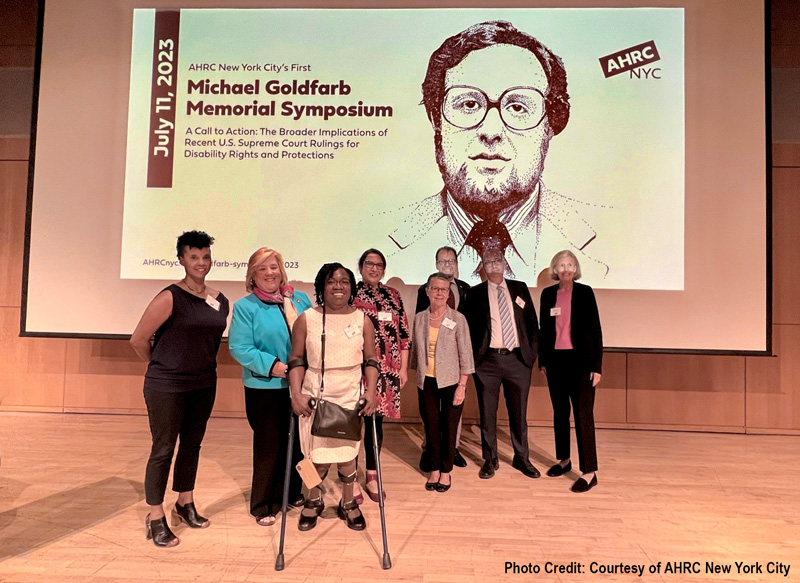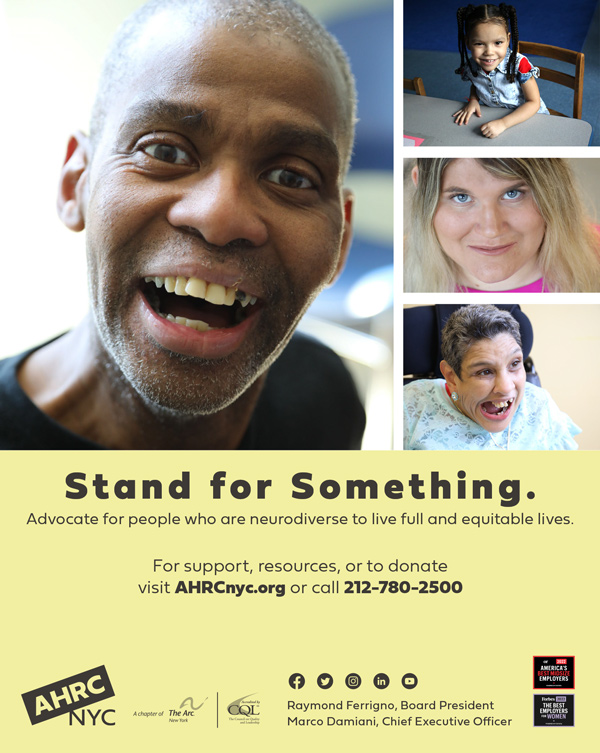Applying a disability lens to the U.S. Supreme Court decisions makes it clear that recent rulings, including affirmative action, have a significant impact on the community, according to a panel of experts at AHRC New York City’s first Memorial Michael Goldfarb Symposium.
“People of color also includes people with disabilities,” said Britney Wilson, Associate Professor of Law and Director of the Civil Rights and Disability Justice Clinic, at New York Law School, who was born with Cerebral Palsy. “There’s a fear of affirmative action as preferential treatment. ‘You’re getting something that is different than what I’m getting. You’re getting an unfair advantage’…that sounds like accommodation! No, it’s actually not fair to treat us all the same, because some people need something else in order to effectively level the playing field.’’

Panelists, moderators, responders and planning committee members of AHRC New York City’s First Michael Goldfarb Memorial Symposium at the CUNY Graduate Center
Kickoff of AHRC NYC’s 75th Anniversary
The symposium, “A Call to Action: The Broader Implications of Recent U.S. Supreme Court Rulings for Disability Rights and Protections,” kicked off AHRC New York City’s 75th anniversary celebration events. It was a fitting tribute to Goldfarb, who served as Executive Director of AHRC NYC for nearly half of its history. He oversaw the agency for 37 years, during which time the field of intellectual and developmental disabilities flourished and created the foundation for most of the services and supports that exist today.
“Disability has always been a part of what happens in the courts,” said Jasmine E. Harris, a law and inequality legal scholar from the University of Pennsylvania’s Carey School of Law, who moderated the panel. “And the courts have always been part of social change in disability. It’s not the whole story but it’s an important part.”
She applied a disability lens to examine Dobbs v. Jackson Women’s Health Organization, which overruled Roe v. Wade. “This is a case that does not have disabled litigants, nor does it implicate disability laws directly,” Harris said. “It should be understood through a disability lens with particularly important effects on disabled people.”
Rebecca Cokley, Program Officer for U.S. Disability Rights at the Ford Foundation, recalled giving birth to her daughter in 2013. As one of three generations of women with achondroplasia dwarfism in her family, she heard the anesthesiologist telling her doctor “’while you’re down there, why don’t you go ahead and sterilize her because people like her don’t need to have any more children.’”
“People with disabilities should be able to access abortion and reproductive rights because we are people, because we have the fundamental right to bodily autonomy,” she added. “That conversation is one that, frankly, I think a lot of people in our community are not comfortable having yet. We’re never going to normalize reproductive health care and reproductive justice in the disability space, if we don’t talk about what those needs are.”
New Yorkers to Vote on Equal Rights Amendment
Fearing the Supreme Court’s rollbacks of rights and protections of people with disabilities and other protected classes, the New York State Legislature approved the Equal Rights Amendment for a second time in January, sending the amendment to New Yorkers for ratification on the ballot in November. The ERA would prohibit government discrimination based on a person’s ethnicity, origin, age, disability, and sex, including their gender-identity, gender-expression, pregnancy, and pregnancy outcome. It would also protect against any government actions that would curtail a person’s reproductive autonomy or their access to reproductive health care. The ERA would, for the first time, explicitly include language to clarify that discrimination based on a person’s pregnancy or pregnancy outcome is sex discrimination – an essential clarification given the national trend of criminalizing people for various pregnancy outcomes, as well as the Supreme Court’s overturning of Roe v. Wade.
Referring to her work for the late Sarah Weddington, lead attorney in Roe v Wade, New York State Assembly Member Rebecca Seawright said Weddington firmly believed that Roe had to be protected through state constitutions. “I think passing it here will give more momentum to having it done on the Federal level,” said Seawright, Chair of the Assembly’s People with Disabilities Committee.
While disability is often overlooked in discussions about the court’s rulings and impact, it doesn’t lessen their importance to people with intellectual and developmental disabilities.
“It’s our responsibility to make sure cases pertaining to disability are being covered to the same extent as other cases, and that aspects of cases related to disability, even if not disability focused, are also highlighted,” said Shira Wakschlag, Senior Director of Legal Advocacy and General Counsel, The Arc of the United States. “And it’s our job to continually educate the court, so they understand the real-life harms involved and how to remedy them to ensure the promise of our federal disability rights laws can be realized.”
Intersectionality and Broadening Partnerships
Where people live, their income, race, gender-identity and other factors impact how people experience disability.
Recognizing that a large section of the disability community lives at the intersection of oppression is critical, said Natalie Chin, Associate Professor of Law and Co-Director of the Disability and Aging Justice Clinic, The City University of New York. While the disabilities rights movement has made major strides, it was considered a largely white, hetero movement led by men with some women, she explained. “Because it was really focused on disability, it kind of forgot that disability isn’t a single issue,” Chin said. “Disability justice encompasses people with disabilities who are people of color, immigrants, LGBTQ and others whose voices have not been heard.”
Panelists urged the audience to think about: who is in the room, who is at the table, who is making a change and who is voicing their life experience.
Disability organizations must forge partnerships to broaden their reach.
“When we talk about what we want to see for people with intellectual and developmental disabilities going forward, we shouldn’t be talking about just disability,” Marco Damiani, CEO of AHRC NYC, said following the discussion. “We should identify legislators who know very little about disability or women’s issues. Our workforce is mostly women of color. We can’t just go to people who are supportive. We have to understand how we influence other people. That’s just the beginning of advocacy. Advocacy has to lead to influence and then impact.”
“Everyone is part of our community,” Cokley said, adding that disability exists in one-third of U.S. households. “It’s about thinking who is the weirdest, most obscure, most eccentric group that we could partner with, that has a piece of this fight and how do we bring them in.? “There is the opportunity to work much more broadly, much more boldly and build the kind of coalitions that other communities have had for decades. But we really have to get out of our own way.”
To view a recording of the summit, courtesy of The CUNY Graduate Center, click here. Use the passcode: ^b.5t@sE






